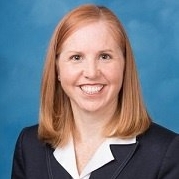Note: The author will present “Using Patient Financial Communications to Improve Estimates and Engagement” at HFMA’s 2019 Annual Conference, June 23-26 in Orlando. The session is part of the Patient Accessibility, Engagement and Experience learning pathway.
Health First is an integrated, not-for-profit system that includes four hospitals, a medical group and health plans serving Central Florida. Since January 2018, we have used a “100% estimate, 100% ask” approach to patient financial communications for all services, inpatient and outpatient, delivered throughout our system. The results have been noteworthy.
(pictured: Michelle Fox, Health First)

In the first month after we went live with this approach, we saw a 27% increase in point-of-service (POS) collections. POS collections at all four hospitals hit 2.8% of net patient revenue, well above the industry average of 0.7% and the best-practice benchmark of 2%.
Equally important, this initiative is improving the patient financial experience because we are proactively setting expectations. When we have the “money talk” with patients, we gain more insight on their financial situation and work with them to help them afford their healthcare.
This strategy also has proved to be a win for our associates on the front lines. Having an estimate of a patient’s out-of-pocket costs allows associates to confidently speak to the patient about his or her insurance benefits and financial responsibility. And because the estimate is in writing and an associate explains what it means, the patient is confident we know what we are talking about.
How the initiative works at Health First
For scheduled outpatients, our preregistration team verifies the patient’s insurance eligibility and benefits and then runs an estimate based on the services being ordered by the physician. Once the patient’s financial responsibility is determined, the preregistration team informs the patient about his or her benefits and total out-of-pocket costs. A request for payment is made during that call.
Registrars use the same process for walk-ins and emergency room patients, and patients are asked for payment at the time of service.
For inpatients, our benefit advisers verify the patient’s insurance eligibility and benefits and create an estimate based on the physician’s orders. The advisers go to the patient’s room to review benefits and out-of-pocket responsibility and to ask for payment.
For self-pay patients in any setting, an estimate is created using our self-pay discount, and payment arrangements are made.
For patients who are unwilling to pay upon request and who do not have any bad debt or outstanding balances with us, we ask for payment over the phone prior to services but allow them to pay when they arrive on the day of service. For patients with bad debt or outstanding balances, we notify them that the financial responsibility for the current appointment must be paid in full before the appointment. Then we refer them to a benefit adviser to make payment arrangements for the outstanding or bad-debt balance. Patients who are unwilling to pay in full for the current appointment get rescheduled to a later date.
When patients cannot afford an elective service but a physician determines that it is medically necessary for the procedure to happen immediately, we help the patient apply for financial assistance.
Hardwiring patient financial conversations
Training is key to giving associates confidence to ask patients for money that is owed. Our associates are trained on how to create an estimate, how to properly explain the estimate and how to request payment. We use scripting and role-playing to ensure we are collecting with compassion and creating a positive financial experience for the patient.
Our staff members use standard scripting as a guideline, but we don’t want them to use it verbatim because these conversations need to be sincere and not robotic. We want our associates to be comfortable in what they are saying to the patient and how they are saying it, so we encourage them to tailor the message as they see fit.
We use a standard checklist to perform periodic observations on all associates and provide timely, objective feedback about their interactions with patients. For the preregistration team, we record all phone calls and perform quality-assurance checks.
Ensuring everyone is on board
As we all know, what gets measured gets done. Associates need to be held accountable daily. At Health First, we communicate the upfront collections each day at the system level and on down to individual hospitals, teams and associates. Equipping them with tools, such as scripting and technology, helps them succeed.
Managers also produce a daily “missed opportunities” report that identifies any accounts with no estimates and accounts that have estimates but no payment collection. The report is discussed with associates to provide education and spark process improvement.
Associates especially need to understand the vision and the “why” of this initiative. Setting the expectation that the patient financial conversation is now part of our everyday routine has helped gain crucial buy-in.





